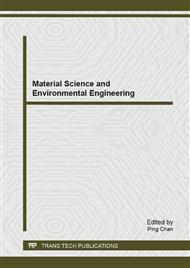[1]
Climate Change 2007: synthesis report. Contribution of Working Groups I, II and III to the fourth assessment report of the intergovernmental panel on climate change. IPCC, Geneva.
DOI: 10.1017/cbo9781107415416
Google Scholar
[2]
R.B. Primack, and A.J. Miller-Rushing: New Phytol 182 (2009), p.303.
Google Scholar
[3]
V.H. Heywood: Biodivers Conserv 20(2011), p.221.
Google Scholar
[4]
Z.Z. Xu and G.S. Zhou: Progr Nat Sci 2(13) (2003), p.113, In Chinese.
Google Scholar
[5]
G.R. Walther, E. Post, P. Convey, A. Menzel , C. Parmesan, T.J.C. Beebee, J.M. Fromentin, O. Hoegh-Guldberg and F. Bairlein: Nature 416(2002), p.389.
DOI: 10.1038/416389a
Google Scholar
[6]
S.E. Diamond, A.M. Framae, R.A. Martin and L.B. Buckley: Ecology 92(2011), p.1005.
Google Scholar
[7]
M.E. Visser: Nature 466(2010), p.445.
Google Scholar
[8]
A.E. Derocher: Nature 468(2010), p.905.
Google Scholar
[9]
H. Thughels, I. Nijs, P. Vanhecke and I. Impens: J Biogeogr 22(2-3) (1995), p.297.
Google Scholar
[10]
S. Httenschwiler: Oecologia 129(1)(2001), pp.31-42.
Google Scholar
[11]
C. B. Field, R. B. Jackson and H. A. Mooney: Plant Cell Environ 18(1995), p.1214.
Google Scholar
[12]
X.F. Yu and D. F. Zhou: Res Sci 28(4) (2006), p.111, In Chinese.
Google Scholar
[13]
Y. G. Li, G. M. Jiang and J. C. Yang: Acta Phytoecol Sin 27(2) (2003), p.164, In Chinese.
Google Scholar
[14]
X.Y. Hao,X. Han,H. Ju,and E.D. Lin: J Appl Ecol 21(10) (2010), p.2697, In Chinese.
Google Scholar
[15]
J. Cheng, J.M. Cheng and T.M. Hu: J Appl Ecol 22(1) (2011), p.35, In Chinese.
Google Scholar
[16]
Q.W. Yuan and J. Li: The Arid Geography 30(4) (2007), p.465, In Chinese.
Google Scholar
[17]
T.T. Meng, J. Li and G. H. Wang: J Plant Ecol 31(1) (2007), pp.150-165, In Chinese.
Google Scholar
[18]
R.B. Primack and A.J. Miller-Rushing: New Phytol 182 (2009), p.303.
Google Scholar
[19]
A.J. Miller-Rushing, D. Primack, R.B. Primack, C. Imbres and P. Del Tredici: Arnoldia 63 (2004), p.26.
DOI: 10.3732/ajb.91.8.1260
Google Scholar
[20]
A.J. Miller-Rushing, R.B. Primack, D. Primack and S. Mukunda: Am J Bot 93 (2006), p.1667–1674.
Google Scholar
[21]
J.S. Dukes and H.A. Mooney: Trends Ecol Evol 14(1999), p.135.
Google Scholar
[22]
L. Ying and B.H. Wu: Pant. Physiol. Commun 37(1) (2001), p.71, In Chinese.
Google Scholar
[23]
Y.B. Guo: Landscape Art ( China Agriculture Press, China 1996), In Chinese.
Google Scholar
[24]
C.J. Zhao and F. Bo: Chinese Garden, 2009, p.1, In Chinese.
Google Scholar
[25]
Y.R. Fu: Proceedings of 2011 (I) at the Chinese academy of landscape architecture, In Chinese.
Google Scholar
[26]
K.E. Trenberth, P.D. Jones, P. Ambenje, R. Bojariu, D. Easterling, A. Klein Tank, D. Parker, F. Rahimzadeh, J.A. Renwick, M. Rusticucci, B. Soden and P. Zhai, in: Climate change 2007: The physical Science Basis. Contribution of Working Group I to the Fourth Assessment Report of the Intergovernmental Panel on Climate Change, editing by S. Solomon, p.235–336, Cambridge University Press (2007).
DOI: 10.1017/cbo9781107415324
Google Scholar
[27]
G.A. Meehl, , T.F. Stocker, W.D. Collins, P. Friedlingstein, A.T. Gaye, J.M. Gregory, A. Kitoh, R. Knutti, J.M. Murphy, A. Noda, S.C.B. Raper, I.G. Watterson, A.J. Weaver and Z. -C. Zhao, in: Climate change 2007: The Physical Science Basis. Contribution of Working Group I to the Fourth Assessment Report of the Intergovernmental Panel on Climate Change, editing by S. Solomon, p.747–845, Cambridge University Press (2007).
DOI: 10.1017/cbo9781107415324
Google Scholar
[28]
S. A. Natasha and T. Clare: Biodivers Conserv 20(2011), p.295.
Google Scholar
[29]
Ü. Niinemets and J. Peñuelas: Trends in Plant Science 13(2) (2008), p.60.
Google Scholar
[30]
J.S. Dukes and H.A. Mooney: Trends Ecol Evol 14(1999), p.135.
Google Scholar
[31]
G.R. Walther, S. Berger and T. S. Martin: Proc Biol Sci 272(2005), p.1427.
Google Scholar
[32]
J. Peñuelas and M. Boada: Glob: Change Biol 9(2003), p.131.
Google Scholar
[33]
M.T. Benjamin and A.M. Winer: Atmos Environ 32(1998), p.53.
Google Scholar
[34]
C.J. Hu and X. Li: Proceedings of 2011 (I) at the Chinese academy of landscape architecture, In Chinese.
Google Scholar


